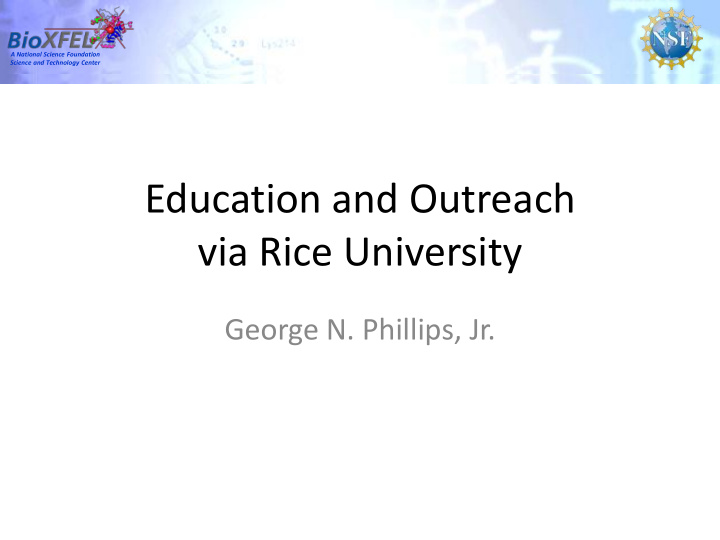



A National Science Foundation A National Science Foundation Science and Technology Center Science and Technology Center Education and Outreach via Rice University George N. Phillips, Jr.
A National Science Foundation Science and Technology Center Crystallographic Education Interactive Software New On-line Course Outreach and K-16 activities Recruitment of underrepresented minorities
Science and Technology Center Crystallographic Education A National Science Foundation New on-line course in introductory X-ray crystallography – includes didactic, interactive and authentic research components Year 1 Initial video capture – done Year 2 “Flipped” course, improved videos Year 3 On-line only, develop all media Year 4 Release MOOC (edX or Coursersa?)
XRayView A National Science Foundation Science and Technology Center Currently has exercises on: • Ewald sphere • Alignment of crystals • Mosaic spread • Resolution • Spot size • Space group determination To be added: • Pulsed X-rays • Streaming samples • Random orientations • Powder patterns • Small crystal size • Pump-Probe
Outreach A National Science Foundation Science and Technology Center • International Year of Crystallography Celebration at Rice University • Sealy Center for Structural Biology Symposium • Society of Computation Geometry Each mentioned BioXFEL and acknowledged it support
IYCr: Structure Matters A National Science Foundation Science and Technology Center The symposium included a presentation by Prof. George Phillips on "Crystallography: What It Is and What It Does For You” followed by Prof. John Spence on "Opportunities for Dynamic Protein Crystallography Using X- Ray Lasers”, and Prof. Stephen Burley from PDB on "Integrative Structural Biology: Role of the Protein Data Bank”. Three buses of high school students attended with their teachers.
Booths for interactive involvement A National Science Foundation Science and Technology Center • Crystallography Over the Years: A Brief History This booth illustrated, in brief, the development of X-Ray Crystallography and milestones reached over the years. • Growing Crystals Angela Criswell, Rigaku Corporation, and her team helped students learn about growing crystals and then viewing them under a microscope. This booth featured the Rigaku Alchemist, an automated system for high-throughput crystal growing. • Light Diffraction Jim Clarage, University of St. Thomas, lead the students through the concepts of light diffraction that lead to the unique patterns created during X-ray diffraction during crystallographic discovery. • Modeling Proteins To understand the 3D structure of proteins, students used paper models to build a 3D representation of protein structures. • Protein Visualization in 3D George Phillips and his team helped students visualize and understand in 3D the structure of proteins and implications of these unique structures. • Structural Analysis Tools . BVV Prasad from the Baylor College of Medicine, showed the students through interactive modules to introduce students to the software and how new information can be gleaned from these tools. Sponsored by NSF/BioXFEL, Rice University, the Rigaku Corp.
Science and Technology Center Diversity and Recruitment A National Science Foundation New Hispanic student on the project at Rice. Jose Luis Olmos from University of Texas Austin is now a first year graduate student at Rice in the Biochemistry and Cell Biology program. He will participate in research and education efforts as a part of BioXFEL activities.
A National Science Foundation Science and Technology Center After Ed Lattman circa 1980
Recommend
More recommend